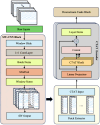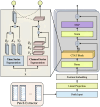Sliding-Window CNN + Channel-Time Attention Transformer Network Trained with Inertial Measurement Units and Surface Electromyography Data for the Prediction of Muscle Activation and Motion Dynamics Leveraging IMU-Only Wearables for Home-Based Shoulder Rehabilitation
- PMID: 40006504
- PMCID: PMC11861537
- DOI: 10.3390/s25041275
Sliding-Window CNN + Channel-Time Attention Transformer Network Trained with Inertial Measurement Units and Surface Electromyography Data for the Prediction of Muscle Activation and Motion Dynamics Leveraging IMU-Only Wearables for Home-Based Shoulder Rehabilitation
Abstract
Inertial Measurement Units (IMUs) are widely utilized in shoulder rehabilitation due to their portability and cost-effectiveness, but their reliance on spatial motion data restricts their use in comprehensive musculoskeletal analyses. To overcome this limitation, we propose SWCTNet (Sliding Window CNN + Channel-Time Attention Transformer Network), an advanced neural network specifically tailored for multichannel temporal tasks. SWCTNet integrates IMU and surface electromyography (sEMG) data through sliding window convolution and channel-time attention mechanisms, enabling the efficient extraction of temporal features. This model enables the prediction of muscle activation patterns and kinematics using exclusively IMU data. The experimental results demonstrate that the SWCTNet model achieves recognition accuracies ranging from 87.93% to 91.03% on public temporal datasets and an impressive 98% on self-collected datasets. Additionally, SWCTNet exhibits remarkable precision and stability in generative tasks: the normalized DTW distance was 0.12 for the normal group and 0.25 for the patient group when using the self-collected dataset. This study positions SWCTNet as an advanced tool for extracting musculoskeletal features from IMU data, paving the way for innovative applications in real-time monitoring and personalized rehabilitation at home. This approach demonstrates significant potential for long-term musculoskeletal function monitoring in non-clinical or home settings, advancing the capabilities of IMU-based wearable devices.
Keywords: deep learning; inertial measurement unit; musculoskeletal analysis; shoulder rehabilitation; surface electromyography.
Conflict of interest statement
The authors declare no conflicts of interest. The funders had no role in the design of the study; in the collection, analyses, or interpretation of data; in the writing of the manuscript; or in the decision to publish the results.
Figures









Similar articles
-
IMU, sEMG, or their cross-correlation and temporal similarities: Which signal features detect lateral compensatory balance reactions more accurately?Comput Methods Programs Biomed. 2019 Dec;182:105003. doi: 10.1016/j.cmpb.2019.105003. Epub 2019 Aug 1. Comput Methods Programs Biomed. 2019. PMID: 31465977
-
Multi-Category Gesture Recognition Modeling Based on sEMG and IMU Signals.Sensors (Basel). 2022 Aug 5;22(15):5855. doi: 10.3390/s22155855. Sensors (Basel). 2022. PMID: 35957417 Free PMC article.
-
Remote Motor Rehabilitation: EMG-IMU based Deep Learning Model Improves the Estimate of Wrist Kinematics.Annu Int Conf IEEE Eng Med Biol Soc. 2024 Jul;2024:1-4. doi: 10.1109/EMBC53108.2024.10782268. Annu Int Conf IEEE Eng Med Biol Soc. 2024. PMID: 40040042
-
Quantifying shoulder motion in the free-living environment using wearable inertial measurement units: Challenges and recommendations.J Biomech. 2025 Mar;182:112589. doi: 10.1016/j.jbiomech.2025.112589. Epub 2025 Feb 17. J Biomech. 2025. PMID: 39987887 Review.
-
Estimation of Lower Extremity Muscle Activity in Gait Using the Wearable Inertial Measurement Units and Neural Network.Sensors (Basel). 2023 Jan 3;23(1):556. doi: 10.3390/s23010556. Sensors (Basel). 2023. PMID: 36617154 Free PMC article. Review.
References
-
- Matsen F.A., Lippitt S.B. Shoulder Surgery: Principles and Procedures. 1st ed. Saunders; Philadelphia, PA, USA: 2003.
MeSH terms
Grants and funding
LinkOut - more resources
Full Text Sources

